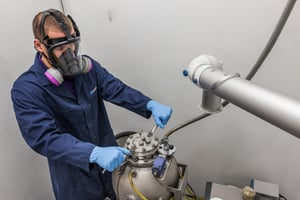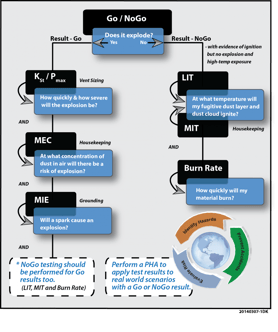The Best Combustible Dust Management Services That Keep Employees Safe
Combustible dust hazards are common in industry and gained additional exposure due to the OSHA Combustible Dust National Emphasis Program (NEP) which was re-issued as a result of the fatal accident at Imperial Sugar. Dust management testing labs offer a wide range of services related to Dust Hazards Analysis (DHA) characterizing, preventing and mitigating combustible dust explosion and fire hazards. These services include combustible dust testing, onsite assessments, Occupational Safety and Health Administration (OSHA) and National Fire Protection Association (NFPA) compliance assistance, audit preparation, training, ignition source evaluation and vent sizing calculations.
"NFPA 652 requires a Dust Hazard Analysis (DHA) if you handle  a combustible dust in your process," states Fauske & Associates Customer Service Manager Mark Yukich. "If you believe that your material is not explosible and/or combustible, test your material to prove that your facility is safe from any of these hazards. If your material is found to be explosible, it is your duty to test the characteristics of your material. The goal of the testing is to determine under what conditions the material will react. When the characteristics of the material is determined, mitigation strategies can be implemented to keep your employees and facility safe from explosion hazards."
a combustible dust in your process," states Fauske & Associates Customer Service Manager Mark Yukich. "If you believe that your material is not explosible and/or combustible, test your material to prove that your facility is safe from any of these hazards. If your material is found to be explosible, it is your duty to test the characteristics of your material. The goal of the testing is to determine under what conditions the material will react. When the characteristics of the material is determined, mitigation strategies can be implemented to keep your employees and facility safe from explosion hazards."
Seek process safety professionals who have served clients in a variety of industries including metal processing, wood/paper products, agriculture, food products, textiles, plastics, pharmaceuticals and many others. When developing mitigation strategies for potentially hazardous, explosive or combustible dusts, it is important to characterize the hazard risk of the material in question by determining its explosion severity and ignition sensitivity. Explosion severity data will determine if an explosion hazard exists and, if so, how energetic it may be while ignition sensitivity data will assess the probability of risk based on how the material responds to heat, spark, impact and frictional forces.
Seek a testing lab that offers the following NFPA, OSHA and NEP Combustible Dust Hazard Assessment (DHA) testing and services for determination of both explosion severity and ignition sensitivity per ASTM and European EN methods:
Explosion Severity Test - (KSt ,PMax and dP/dtMax)
- ASTME 1226 – 2010 - Determines values necessary for designing protective measures, such as deflagration venting
- EN14034 - Part 1:2004 - Determination of the Maximum Explosion Pressure (Pmax) of Dust Clouds – Part 2:2006 - Determination of the Maximum Rate of Explosion Pressure Rise (dP/dtMax ) of Dust Clouds
Minimum Ignition Energy - (MIE)
- ASTM E2019 - Standard Test Method for Minimum Ignition Energy of a Dust Cloud in Air
- EN13821:2002 - Potentially Explosive Atmospheres - Explosive Prevention and Protection - Determination of Minimum Ignition Energy of Dust/Air Mixtures
Minimum Explosible Concentration - (MEC)
- ASTM E1515 - Identifies the Minimum Hazardous Concentration of a Dust Cloud that will Sustain Combustion
- EN14034-3:2006 - Determination of Explosion Characteristics of Dust Clouds - Part 3: Determination of the Lower Explosion Limit (LEL) of Dust Clouds
Minimum Autoignition Temperature of a Dust Cloud - (MIT)
- ASTM E1491 - Determines Safe Operating Temperatures at Which a Dust Cloud Will Not Autoignite
- EN50281-2-1:1999 - Electrical Apparatus for Use in the Presence of Combustible Dust - Part 2-1: Test Methods - Methods for Determining the Minimum Ignition Temperatures of Dust
Hot Surface Ignition Temperature of Dust Layers - (LIT)
- ASTM E2021 - Identifies Dangerous Operating Temperatures at Which a Dust Layer Will Self-Heat
- EN50281-2:1999 - Electrical Apparatus for Use in the Presence of Combustible Dust - Part 2-1: Test Methods - Methods for Determining the Minimum Ignition Temperatures of Dust
Limiting Oxygen Concentration - (LOC)
- Defines Safe Nitrogen Inerting Levels to Prevent Dust Cloud Explosion
- EN14034-4:2004 - Determination of Explosion Characteristics of Dust Clouds - Part 4: Determination of the Limiting Oxygen Concentration LOC of Dust Clouds
Testing should be completed on-site in a state of the art dust testing facility per ISO 17025 guidelines.
COMBUSTIBLE DUST HAZARD BASICS -WHAT DOES A GO/NO-GO TEST MEAN?
 Very often, when performing dust and explosibility testing quotes for customers, we are asked what exactly a Go/No-Go test is? While we offer a list of testing services to determine the deflagration hazards of dust samples per ASTM (American Society
Very often, when performing dust and explosibility testing quotes for customers, we are asked what exactly a Go/No-Go test is? While we offer a list of testing services to determine the deflagration hazards of dust samples per ASTM (American Society
In order to "screen" for the possibility of dust explosibility in your facility, we perform a Go/No-Go Screening Test. Based on ASTM E1226, "Standard Test Method for Explosibility of Dust Clouds", this test is an abbreviated set explosion severity method with three dust concentrations to determine if the sample is explosible. This test is generally performed with samples tested "as received" or sieved with a 40 mesh (420μm) screen and using one 5-kJ chemical igniter as the ignition source. [>100 grams (~¼ lb) of sample less than 420μm required]
In a previous post: "How To Collect and Ship Combustible Dust Samples For Testing", we discussed the simple steps for getting your samples to a lab for testing. See below for our chart that discusses the outcomes for your dust tested. If your test sample is a "Yes, it explodes" then further tests can be run to determine how quickly and how severe the explosion will be (KSt/Pmax Test), followed by testing what concentration of dust in the air will cause a risk of explosion (MEC Test). Next, another test can determine if a spark will cause an explosion (MIE) test.
But, what if your Go/No-Go test result is a "no"? Well, we next look at what temperature it will take make your dust layer ignite. To find the Minimum Autoignition Temperature (MIT) of a dust cloud in the air, the MIT tests the minimum temperature that would cause your dust cloud to ignite. Next, is the LIT Test, which determines the hot-surface ignition temperature of dust layer. Finally, a Burn Rate test is conducted to determine how quickly the dust material will burn.
All of these tests start with the Go/No-Go Test. A comprehensive DHA or Process Hazards Analysis (PHA) can apply your test results to real world scenarios at your facility. Better to know what you are dealing with so you can plan safely! In addition, if you have a dust collector and aren't sure what to do next, read: "Combustible Dust Made Easy".
Here are some other tests run for dust explosibility screening:
- Combustible Dust Hazard Screening Test - Based on VDI2263 and UN 4.1 combustion testing. This test is to determine if a dust in a pile supports self-sustaining flame propagation. [>30 grams(~1oz)of sample less than 420μm required; >300 grams (~2/3 lb) of sample less than 420μm required if testing metal
dusts ] - Go/No-Go Screening + Combustible Dust Screening Package - Both tests run in tandem as a screening package
- Sample Characterization Test - includes determining the sample moisture content and particle size distribution [>30 grams of samples less than 420μm required]
- “Hard-to-ignite” Explosibility Test - Tested as above but with a 400 J ignition source. [>100 grams (~¼ lb) of sample less than 420μm required]
Furthermore, please note that per ASTM recommendations (and some NPFA requirements); samples should be tested at a particle size less than 75 μm and less than 5% moisture. Please note that testing materials in a method not complying with the ASTM/EU recommendations may produce explosion severity and explosion sensitivity data that is not considered conservative enough for explosion mitigation design.
ON-SITE DUST HAZARD ASSESSMENTS (DHA)
Combustible dust experts can visit your facility to evaluate your receiving, storage, use, processing and disposal of all “powder” materials. They will evaluate existing dust management programs, handling practices, equipment, fire/explosion suppression systems, warning devices and onsite extinguishing capabilities. Possibilities for fugitive dust control will also be identified where appropriate. A testing lab and its experts can provide the following onsite services:
- Incident investigation for dust explosions and fires
- Evaluate compliance with relevant national, local and industry standards
- Electrostatic hazards – e.g. grounding and bonding issues
- Recommendations for explosion hazard risk reduction
- Identify dust sampling points and collect samples for dust explosibility testing
NFPA and OSHA NEP Combustible Dust Compliance
- Preparation for an OSHA Combustible Dust NEP inspection, including appropriate responses to inspector’s questions
- Perform a Process Hazard Analysis (PHA) for compliance with NFPA
- Documentation review for NFPA and OSHA Combustible Dust NEP requirements
- Testing services to meet all NFPA and OSHA Combustible Dust NEP requirements
- Conduct employee training to comply with OSHA Combustible Dust NEP requirements
Additional Services
- Vent size calculations for new or existing equipment (American and European standards)
- Ignition source evaluation (NFPA 654 and 77)
- Electrical area equipment classification (NFPA 499)
- Integration of combustible dust hazard management into existing process safety programs for process safety management (PSM) facilities
- Development of process safety programs to manage combustible dust hazards for non-PSM facilities
TRAINING
Train your staff in the understanding of technical issues, process safety programs or audits, regulations and more. A comphrehensive perform process safety audits as part of a comprehensive hazards analysis and can work with you to make sure your staff is supplied with skills training needs in many ways including:
Level I - Gap Analysis
Level II - Training & Consulting
Level III - Program Development and Implementation
Partial List of Services You Should Seek:
• Reviews and upgrades of all your safety process systems and regulatory requirements
• VPP Consulting
• Audits, reviews, and upgrades of all your Operating, Safety, and Maintenance Procedures
• Training program evaluations for both completeness and effectiveness (from technical skills to professional development) and upgrades where needed
• Reviews and upgrades of your program elements such as Employee Participation and Process Safety Information for effectiveness and completeness
• Work process effectiveness evaluations and upgrades
• Overall organizational development (e.g., motivation, work processes)
• Stress reduction
• Evaluations of the effectiveness of communication
A full service testing lab will design, custom develop and deliver any site specific training materials needed by your organization. Consultants, Engineers and Technical Specialists should be available to deliver the classroom, lab or on-the-job training your staff needs. In addition, provide assistance with the identification and procurement of commercially available training materials where available.


